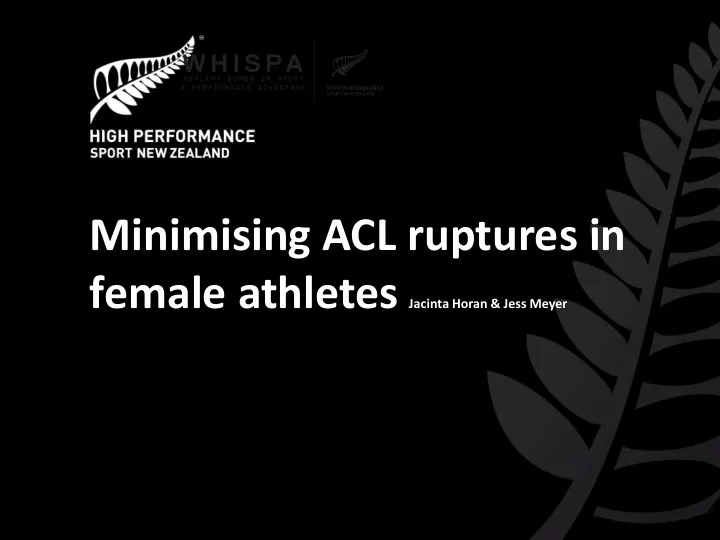

Minimising ACL ruptures in female athletes Jacinta Horan & Jess Meyer
WHISPA • Multidisciplinary group • HPSNZ & external • Evidence based guideline production and dissemination • Physio focus on ACL injuries • Website and resources available
Statistics 2013 • >5000 ACL ruptures/year • 15 - 29 years largest incidence • Sport breakdown – 24% of all ACL ruptures across rugby, netball and soccer • 2948 ACL reconstructions in NZ • 68% ACL reconstructions = rugby, netball and soccer • Surgery = $29.5 million • $8 million other costs • $3-5 million additional healthcare costs ie physio • total costs > $40 million per year
Costs • Individuals, healthcare systems and teams • Financial • Time • Social – ie isolation, decreased self esteem • Psychological aspects of missed athletic performance • Long term disability – OA • 20 – 50% never return to same level of sport • Team performance – teams with the least injuries win the most
Research • ACL rupture rates are 4 – 8 x higher in females than their corresponding male counterparts in the same sports (Arendt et al, Bjordal et al, Engstrom et al, Gray et al) • Female and male rates equivalent pre puberty • ACL ruptures are predominantly non contact in nature: • deceleration • change of direction manoeuvre • landing injury • Increasing frequency of ACL injuries in our female athletic population
Risk factors • There are a large number of potential intrinsic and extrinsic risk factors including but not limited to: • Genetics • Gender • Neuromuscular control • Anatomic • Biomechanical • Hormone
Research and risk factors • ACL rupture is greater during the pre-ovulatory phase • The effects are on the active restraints of the knee: • neuromuscular control – modifiable risk • Post puberty females: • strength, power and control doesn ’ t increase as it does in males • reduced neuromuscular control
Neuromuscular control MODIFIABLE RISK FACTOR – ACL ruptures • Neuromuscular control deficits in jump landing, cutting and deceleration. • Valgus knee collapse characteristic of female ACL injury
Prevention programmes • Neuromuscular retraining reduces the number of ACL injuries in young female athletes in team sports • Positive effects on those with and without history of ACL ruptures • Greatest effects on athletes 14 – 18 yrs age • Power, strength and neuromuscular control are poorer in this age group
Particulars of ACL Prevention Programmes • Frequency and length of time required is unknown • Higher the volume of prevention training the greater the reductions in ACL injuries • >1 x per week to be effective • Must start in the preseason • Must include neuromuscular control, plyometrics and sports specific skills such as cutting • Multifaceted programme
Particulars cont. • Team warm up ideal situation • Coach led • Supervised • Feedback given on technique in order to be most effective • Higher compliance = greater results • Ideally starts pre puberty ie 11 – 12 yrs age for best results
Research results on “Prevention Programmes ” • Reduction in ALL ACL injury rates up to 50% • Contact and non contact • Male and female • Reduction ACL injury rates up to 70% (non contact) • Reduction in ACL injury rates = male baseline rates • (Webster & Hewitt, 2018)
Current NZ Warmup prevention programmes • http://netballnz.co.nz/useful-info/netball-smart • https://www.rugbysmart.co.nz/sportsmart-warm-up • http://fit4football.co.nz/the-11plus/11plus • http://fit4football.co.nz/the-11plus/11plus-kids
Comparison of NZ ACC sports smart warmups to research findings ✔ Multifaceted programmes ✔ Time appropriate ✔ Warmup based ✔ Frequency recommended appropriate ✔ Online resources identify importance of correct technique What is needed? • Education and buy in: • sports, schools, clubs, coaches, managers, parents and athletes particularly from young ages • Netball and football currently in process of rolling out regionalised programmes of their sportsmart warmups
ACLs and Performance • Teams and individual athletes with least number of injuries WIN the most • Ability to complete >80% of full training over the year results in 7 x higher chance of athletes achieving their performance goals • Reduced injury rates -> Maximised training potential - > Increased success
WHISPA recommendations
Recommend
More recommend